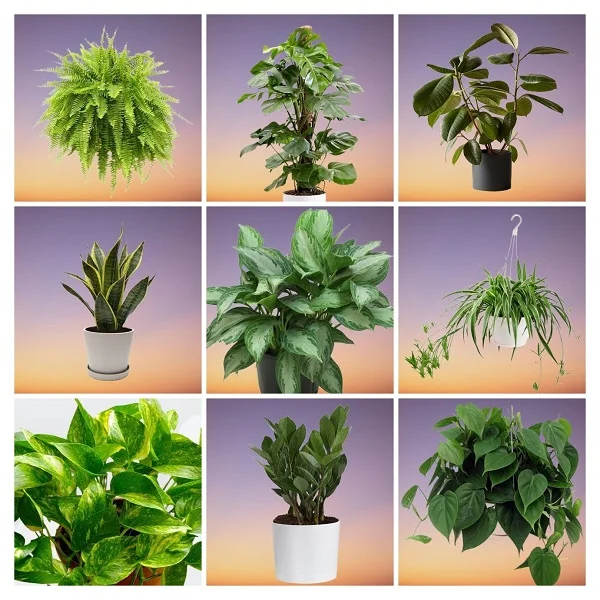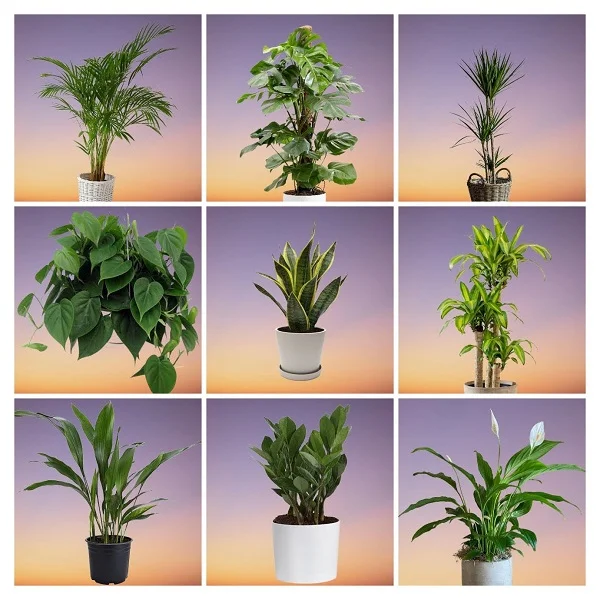20 Large-leafed Indoor Plants that Make a Bold Statement in any Space
Some links in this post may be affiliate links
Large-leafed indoor plants will make a bold statement and add that wow factor in any space. They are perfect for filling up the large spaces.
Some of the statement plants are easy to grow under room conditions and generally require little attention. While selecting these plants, consider the level of care required as well as the space available.
Stand alone indoor plants can grow quite large, however, the size can be controlled by pruning. These plants act as a focal point in any space.
Below is our selection of 20 best large-leafed plants to add elegance to your home with names and pictures.
20 Best Statement Indoors Plants with Care Guides
The best large-leafed plants are Swiss Cheese Plant, Rubber Plants, Anthurium brownii, Umbrella Tree, Fiddle Leaf Fig, Philodendron sagittifolium, Calathea orbifolia among others.
1. Swiss Cheese Plant

Botanical name: Monstera deliciosa
Common names: Swiss Cheese Plant, Split Leaf Philodendron, Monster Fruit, Mexican Breadfruit, Windowleaf Plant
Origin: Southern Mexico
Height: 20 ft
Swiss Cheese Plant is one of the popular Monstera varieties whose large deeply perforated leaves are a sight to behold, is easy to grow even for a beginner and is a good indoor air cleaner.
Monstera deliciosa is a ideal as a stand alone plant for occupying large empty spaces. To produce an upright plant, provide a moss stick to support it and also push the aerial roots into the soil. It is among the best plants for the living room where it will create a great first impression.
Split Leaf Philodendron blossoms in bright to medium, indirect light away from direct sunlight, warm and humid conditions and moderately moist, fertile, well-drained, all purpose potting soil coupled with monthly feeding during the growing period.
Learn more on how to grow and care for Swiss Cheese Plant (Monstera deliciosa)
2. Rubber Plants

Botanical name: Ficus elastica
Common names: Rubber Plant, Rubber Fig, Rubber Tree, Rubber Bush, Indian Rubber Tree, Indian Rubber Bush
Origin: South Asia and Southeast Asia
Height: 6-10 ft
Rubber Plants are some of the popular Ficus plants varieties are are ideal bold statement plants that are easy to grow and easily adaptable to indoor growing conditions. They are also good indoor air cleaners.
There are many varieties of Rubber plants to choose and include Ficus elastica 'Decora', Ficus elastica 'robusta' (Bronze Rubber Plant), Ficus elastica 'Black Prince', Ficus elastica 'Tineke', Ficus elastica 'Shivereana' among others.
Ficus elastica grows best in bright light with some direct sunlight, warm and humid conditions and moderately moist, fertile, well-drained soil coupled with monthly feeding during the growing season.
Learn more on how to grow and care for Rubber Plants (Ficus elastica)
3. Anthurium brownii
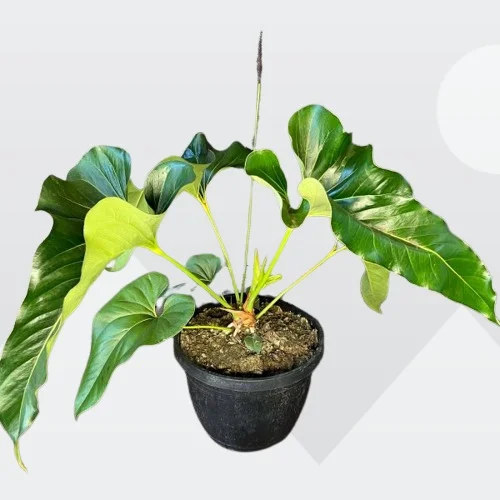
Botanical name: Anthurium brownii
Common name: Anthurium brownii
Origin: Costa Rica to Columbia
Height: 2-3 ft
Anthurium brownii is among the popular Anthurium varieties with large, curly, ribbed, yellow-veined, heart-shaped leaves which stand out in any space and feel like a fiddle leaf fig in texture.
Anthurium brownii and its relatives Anthurium crystallinum (Crystal Anthurium), Anthurium veitchii (King Anthurium), Anthurium warocqueanum (Queen Anthurium) and Anthurium metallicum are some of the best large-leafed Anthurium plants for making a bold statement in any space.
Anthurium brownii flourishes in bright indirect light away from direct sunlight, average warmth of 16-270C, humidity of 60-80% and consistently moist, fertile, well-drained, aroids soil coupled with monthly feeding during the growing season.
Learn more on how to grow and care for Anthurium brownii
4. Umbrella Tree
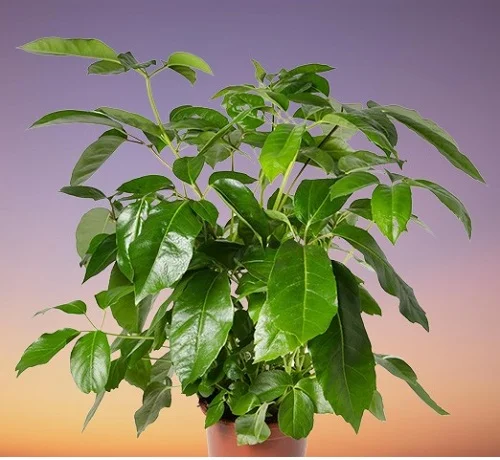
Botanical name: Schefflera actinophylla
Common names: Umbrella Tree, Octopus Tree, Australia Umbrella Tree, Queensland Umbrella, Amate
Origin: Queensland, Northern Australia, New Guinea and Java
Height: 6-8 ft
Umbrella Tree is one of the popular, easy to grow and propagate large, low-light, tree-like plants and is an ideal bold statement plant for the large spaces.
Schefflera actinophylla gets its common name, 'umbrella Tree', from its large finger-like glossy leaflets radiating like umbrella spokes. The common name, 'Octopus Tree', is because of its spectacular, red-colored, tentacle-like flowers.
Australia Umbrella Tree grows best in bright light away from direct sunshine, moderate warmth average humidity and moderately moist, rich, well-drained, all purpose soil coupled with monthly feeding in the growing season.
Learn more on how to grow and care for Umbrella Tree (Schefflera actinophylla)
5. Fiddle Leaf Fig
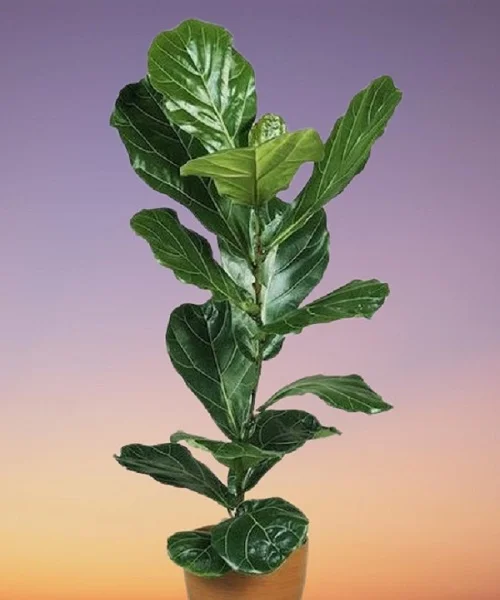
Botanical name: Ficus lyrata
Common name: Fiddle Leaf Fig
Origin: western Africa; Cameroon West to Sierra Leone
Height: 6-10 ft
Fiddle Leaf Fig is a good choice for a large-leafed, bold statement plant. The striking large violin-like leaves are spectacular in the large spaces.
Ficus lyrata is relatively tough and can withstand less than perfect conditions fairly well. The leaves are up to 1.5 feet long, leathery in texture, have prominent veins and a wavy margin. It is one of the best indoor trees for the home.
Fiddle Leaf Fig prefers bright light with some direct sunlight, warm and humid conditions and moderately moist, fertile, well-drained, all purpose soil coupled with monthly feeding during the growing season.
Learn how to grow and care for Fiddle Leaf Fig (Ficus lyrata)
6. Philodendron sagittifolium
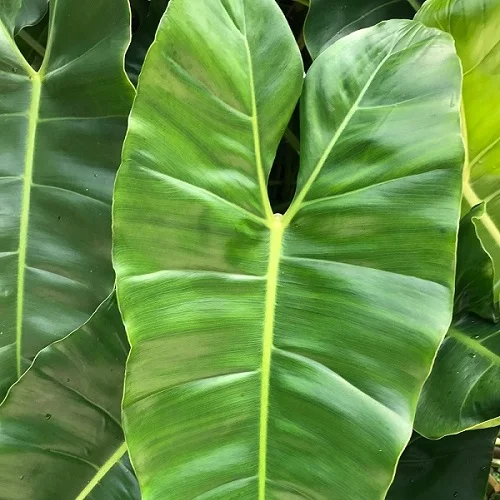
Botanical name: Philodendron sagittifolium
Common name: Philodendron sagittifolium
Origin: Brazil, Mexico, Peru
Height: 10 ft
Philodendron sagittifolium is one of the vigorously-growing, climbing Philodendron varieties whose large, arrow-shaped leaves are pale-green on top and the undersides are dark-green with light green spots.
Philodendron sagittifolium unlike Philodendron selloum (Lacy Tree Philodendron), Philodendron selloum 'Sun Red' and Philodendron 'Summer Glory' can be grown as a climber on a trellis or moss stick where it can display its large leaves. The stems require a firm support to prevent the plant from toppling over.
Philodendron sagittifolium prospers in bright indirect light away from direct sunlight, average warmth of 18-250C, humidity of 60-70% and moderately moist, fertile, well-drained, all purpose soils coupled with monthly feeding during the growing season.
Read more on how to grow and care for Philodendron sagittifolium
7. Calathea orbifolia
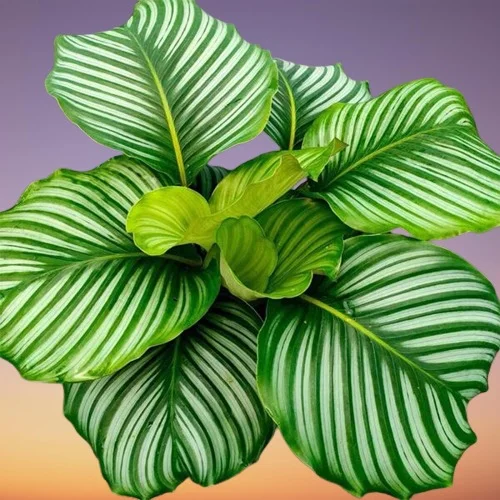
Botanical name: Calathea orbifolia
Common names: Calathea orbifolia
Origin: Northeast and southeast regions of Brazil.
Height: 8 ft
Calathea orbifolia sometimes called Round-leaf Calathea is one of the popular Calathea plants which bears large, round leaves whose surfaces is light-green with lighter-green variegation along the rib and margins and is a perfect stand alone plant.
Calathea orbifolia is an easy-care plant which requires medium, indirect light, warm and humid conditions and moderately moist, rich, free-draining, all purpose potting mix coupled with regular feeding during the growing season.
8. Peace Lily
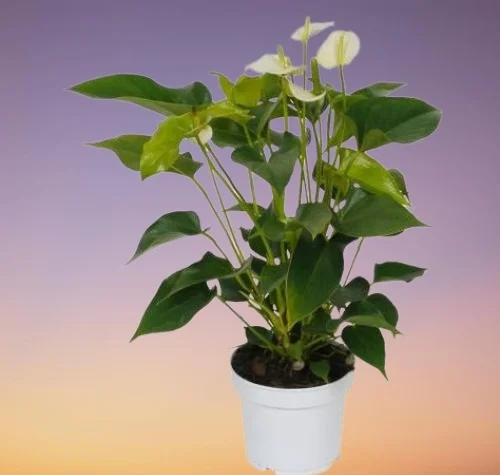
Botanical name: Spathiphyllum wallisii
Common names: Peace Lily, White Sails, Spathe Flower
Origin: Central America, Southeastern Asia
Height: 3 ft
Peace Lily is one of the most popular indoor plants on account of its ability to clean the air while the large, dark-green glossy leaves and white blooms will brighten any space.
The bloom in White Sails is a spathe which appears pale green as it begins to grow and turns white at it opens. It surrounds a spadix that is densely covered by tiny, white flowers.
Spathiphyllum wallisii thrives in bright, indirect light away from direct sunlight, warm and moderately humid conditions and moderately moist, well-drained soil that is rich in organic matter coupled with monthly feeding during the growing season.
Learn more on how to grow and care for Peace Lily (Spathiphyllum wallisii)
9. Alocasia 'Regal Shield'
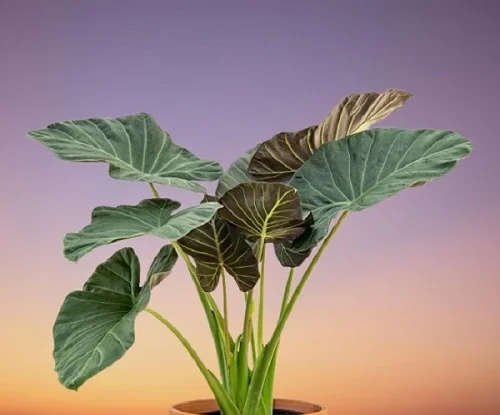
Botanical name: Alocasia odora X Alocasia reginula
Common names: Alocasia 'Regal Shield', Regal Shield Elephant Ear, Regal Shield Alocasia
Origin: Africa
Height: 5 ft
Alocasia 'Regal Shield' is one of the popular Alocasia varieties which bears large, heart-shaped dark-green to almost black leaves with light-green venation on light-green stems.
Regal Shield Elephant Ear like Alocasia micholitziana (Green Velvet Alocasia) and Alocasia longiloba is highly adaptable to a wide range of growing conditions and will make a perfect bold statement plant for a narrow space.
Alocasia 'Regal Shield' blossoms in bright indirect light away from direct sunlight, average warmth of 15-270C, humidity of 60-70% and moderately moist, fertile, well-drained, aroids potting soils coupled with monthly feeding during the growing season.
Read more on how to grow and care for Alocasia 'Regal Shield'
10. Bird's Nest Fern

Botanical name: Asplenium nidus
Common names: Bird's Nest Fern, Asplenium Fern
Origin: East africa, Asia
Height: 2 ft
Bird's Nest Fern is a large and bold plant, beautiful enough to be displayed as a focal point plant. The spear-like leaves can grow up to 3 feet long and are fragile, ensure that they are not crushed and that they have adequate room to develop.
Due to its affinity for high moisture, Asplenium Fern is one of the best plants for a closed terrarium. The magnificient green leaves are a sight to behold inside a terrarium.
Asplenium nidus prefers bright indirect light, average warmth of 15-250C, humidity of 60-70% and consistently moist, rich, well drained, all purpose potting soils coupled with monthly feeding during the growing season.
Learn more on how to grow and care for Asplenium Fern (Asplenium nidus)
11. Caladiums
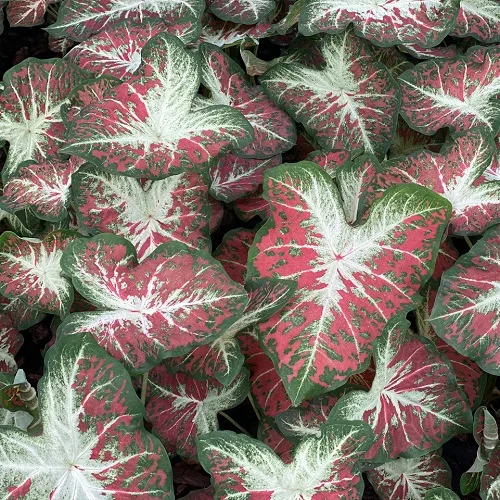
Botanical name: Caladium hortulanum
Common names: Caladium, Elephant Ear, Angel Wings, Heart of Jesus Plant
Origin: South America, Central America
Height: 2 ft
Caladiums bear large, striking arrow-shaped, paper thin and beautifully marked leaves which will add a wow factor in any space. The common colors are white, pink and red.
There are numerous spectacular Caladium plants varieties like Caladium Blushing Bride, Caladium Broken Heart, Caladium Burning Heart, Caladium candidum, Caladium Cranberry Star, Caladium Dawn to Dusk, Caladium Daydreamer among others.
Caladium hortulanum grows best in medium to bright, indirect light, average warmth of 15-260C, humidity of 55-65% and moderately moist, well-drained, all purpose soils coupled with regular feeding in the growing season.
Read more on how to grow and care for Caladiums (Caladium hortulanum)
12. Corn Palm
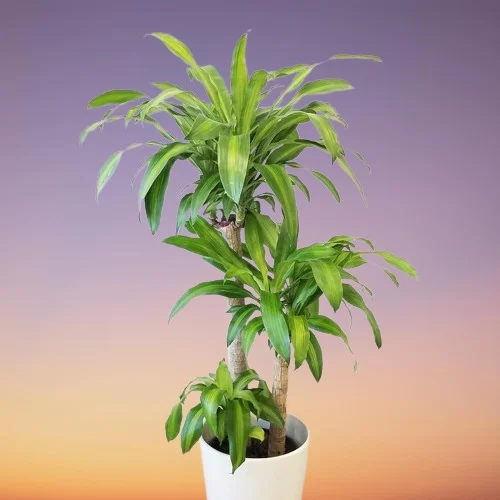
Botanical name: Dracaena fragrans
Common names: Corn Palm, Corn Plant, Striped Dracaena, Compact Dracaena
Origin: Sudan south, Mozambique, C么te d'Ivoire, Angola
Height: 6 ft
Dracaena Corn Plant is one of the easy-care Dracaena varieties whose glossy, large, yellow-striped leaves will brighten up any space. The leaves can grow upto 1.5 feet long and about 10 inches wide.
Corn Palm sheds the lower leaves as it grows, leaving a bare stem with a cluster of leaves at the top which makes it look like a palm and hence the common name.
Dracaena fragrans blossoms in bright, indirect light (dappled light), average warmth of 16-280C, moderate humidity of 50-55% and consistently moist, rich, well-drained, all purpose soil coupled with monthly feeding during the growing season.
Read more on how to grow and care for Corn Palm (Dracaena fragrans)
13. Cast Iron Plant
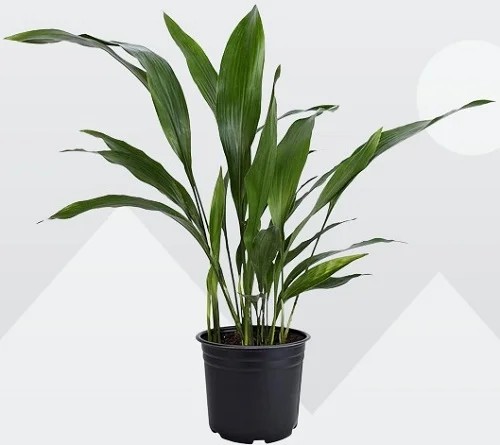
Botanical name: Aspidistra elatior
Common name: Cast Iron Plant
Origin: Taiwan and islands in southern Japan
Height: 1.5-2.5 ft
Aspidistra elatior is one of the highly tolerant plants and is among the near-impossible to kill plants as it easily adapts to less than perfect growing conditions.
Cast Iron Plant varieties include Okame whose green leaves bear dramatic white streaks along the leaf length, Lennon's Song whose leaves bear light green or yellow vertical stripes, Ashahi whose leaf tips become white as the plant grows among others.
Aspidistra elatior performs best in bright light away from direct sunlight (filtered light), average warmth of 15-260C, moderate humidity of 50-55% and moderately moist, fertile, well-drained, succulents soil coupled with monthly feeding in the growing season.
Learn more on how to grow and care for Cast Iron Plant (Aspidistra elatior)
14. Croton Plants
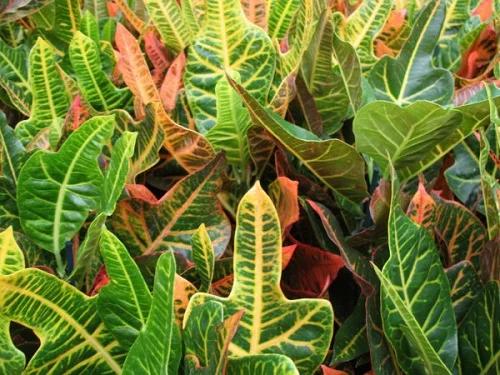
Botanical name: Codiaeum variegatum
Common names: Croton Plant, Joseph's Coat
Origin: Indonesia, Malaysia, Australia and Western Pacific Ocean islands
Height: 9 ft
Croton Plants are popular bold statement plants on account of their vivid foliage colors and varied leaf shapes. They bear large, thick, leathery, shiny, stiff leaves on an upright stem; the usual pattern is large and lobed foliage on which are distinctly colored veins.
Joseph's Coat may not be easy to grow indoor due to their requirement for high humidity and bright light but if cared for properly, they make resilient and beautiful plants ideal for home decor. They are among the best sun-loving plants and are some of the best plants for a sunny balcony.
Codiaeum variegatum requires bright light with 4-6 hours of direct morning or late evening sunlight, average warmth of 18-270C, humidity of 60-70% and consistently moist, rich, well-drained, all purpose soil coupled with regular feeding during the growing season.
Read more on how to grow and care for Croton Plants (Codiaeum variegatum)
15. Ponytail Palm
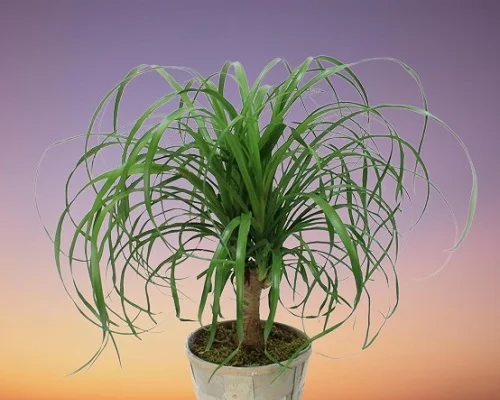
Botanical name: Beaucarnea recurvata
Common names: Ponytail Palm, Elephant Foot
Origin: Tamaulipas, Veracruz and San Luis Potosi in eastern Mexico
Height: 6 ft
Ponytail Palm is very, hardy plant perfect for a beginner or the forgetful plant parent. It is topped by a plume of long, strap-like leaves which gives it the common name, 'Ponytail Palm'.
Beaucarnea recurvata has a large, swollen bulb that stores water which resembles an elephant's foot and hence the common name 'Elephant Foot'. This places this plant among the best plants with low water needs.
Beaucarnea recurvata prefers bright light 4-6 hours of direct sunlight, average warmth of 50-55%, moderate humidity of 50-55% and moderately moist, rich, well-drained, succulents potting mix coupled with monthly feeding in the growing season.
Learn more on how to grow and care for Ponytail Palm (Beaucarnea recurvata)
16. Dumb Cane
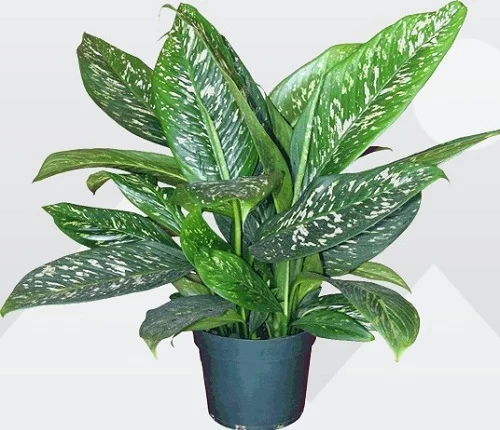
Botanical name: Dieffenbachia
Common name: Dumb Cane
Origin: Mexico, West Indies
Height: 5 ft
Dieffenbachias are some of the best tropical foliage plants for the home which bear large and highly decorative leaves. They are easy to grow and are also good indoor air cleaners.
The common name, "Dumb Cane", is derived from the unpleasant effect of its poisonous sap on the mouth and throat. Dieffenbachia is poisonous to both humans and pets if ingested. Always wash hands thoroughly after handling it.
Dumb Cane (Dieffenbachia) prospers in bright indirect light, average warmth of 18-26, humidity of 50-55% and moderately moist, fertile, well-drained, all purpose soils coupled with fortnightly feeding in the growing season.
Read more on how to grow and care for Dumb Cane (Dieffenbachia)
17. Bird of Paradise Plant

Botanical name: Strelitzia reginae
Common names: Bird of Paradise Plant, Crane Flower
Origin: South Africa
Height: 5-7 ft
Bird of Paradise Plant is one of the most spectacular flowering indoor plants with vivid bright orange and blue flowers which can last for several weeks are borne on top of tall stalks and surrounded by large leaves.
Crane Flower is related to Strelitzia nicolai (White Bird of Paradise Plant) which bears large, paddle-shaped, grey-green leaves arranged in a fan-like shape and Ravenala madagascariensis (Traveller's Palm) with paddle-shaped leaves on long petioles, arranged in a fan-shape in a single plane.
Strelitzia reginae floushes in bright light with 4-6 hours of direct sunshine, cool to average warmth of 13-270C, humidity of 60-70% and consistently moist, rich, well-drained, all purpose potting mix coupled with monthly feeding during the growing season.
Learn more on how to grow and care for Bird of Paradise Plant (Strelitzia reginae)
18. Polka Dot Begonia
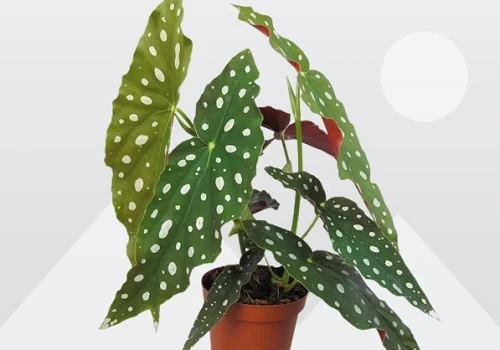
Botanical name: Begonia maculata
Common names: Polka Dot Begonia, Trout Begonia, Spotted Begonia
Origin: Brazil
Height: 8 ft
Polka Dot Begonia also called Trout Begonia or Spotted Begonia is among the popular Begonia plants varieties and bears large, glossy, olive-green leaves blotched with white dot-like spots and hence the common name.
Spotted Begonia may be less spectacular in bloom than other Begonia varieties but like Begonia coccinea (Angel Wing Begonia) and Begonia lucerna, it has the advantage of keeping its large, beautiful "Angel Wing" leaves through out the year.
Begonia maculata grows best in bright, indirect light (filtered light), moderate warmth of 18-260C, average humidity of 50-55% and consistently moist, rich, well-drained, all purpose potting soil coupled with weekly feeding during the growing season.
Read more on how to grow and care for Polka Dot Begonia (Begonia maculata)
19. Japanese Aralia

Botanical name: Fatsia japonica
Common names: Japanese Aralia, Paperplant, Glossy-leaf Paper Plant
Origin: southern Japan, southern Korea and Taiwan
Height: 4-6 ft
Japanese Aralia is an excellent, hardy, bold statement plant which bears large, deeply lobed and leathery textured leaves which makes it one of the best large low-light plants for the living room.
Paperplant has been shown to be a good indoor air cleaner which effectively removes formaldehyde gas from indoor air. One of its common variety is Spider's Web or Spider White which bears variegated leaves.
Fatsia japonica blossoms in medium to bright light, average warmth of 15-26, moderate humidity of 50-55% and moderately moist, fertile, well-drained, all purpose potting soil coupled with monthly feeding during the growing season.
Learn how to grow and care for Japanese Aralia (Fatsia japonica)
20. Dracaena deremensis

Botanical name: Dracaena deremensis
Common name: Dracaena deremensis
Origin: Tropical Africa and Asia
Height: 4-6 ft
Dracaena deremensis is a slow-growing plant which bears dark-green foliage with one or more longitudinal stripes in a different color and comes in several varieties like Janet Craig, Warneckii, Lemon Suprise, Janet Craig Compacta among others.
Dracaena deremensis is a magnificent large statement plant which makes it one of the best plants for the front porch or entrance.
Dracaena deremensis flourish in bright indirect light (filtered light), average warmth of 18-270C, moderate humidity of 50-55% and consistently moist, rich, well-drained, all purpose soil coupled with monthly feeding in the growing season.
Read more on how to grow and care for Dracaena deremensis
